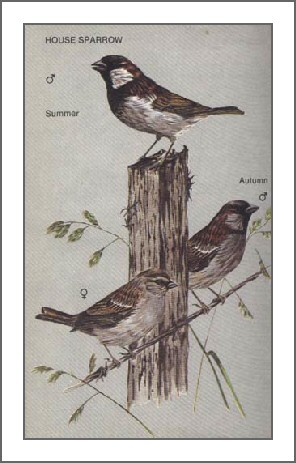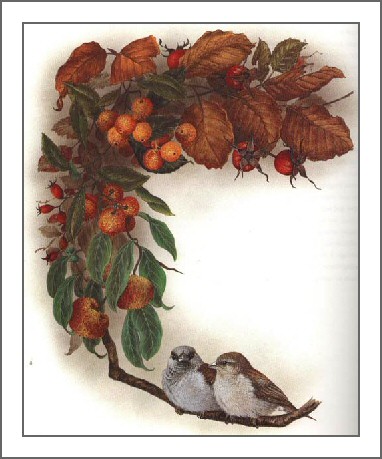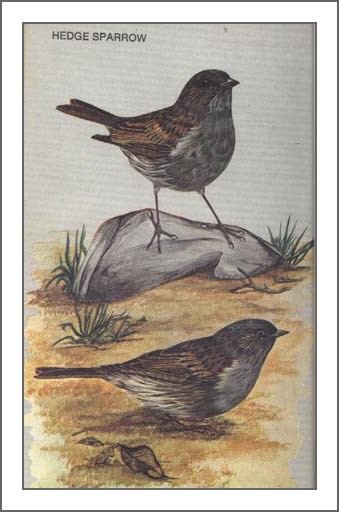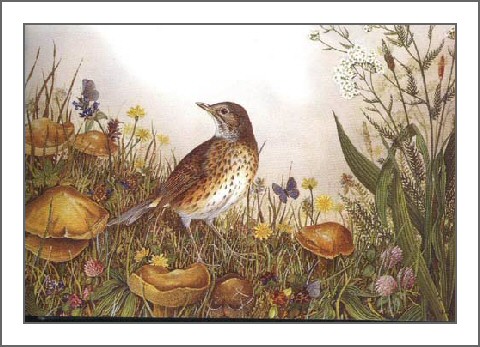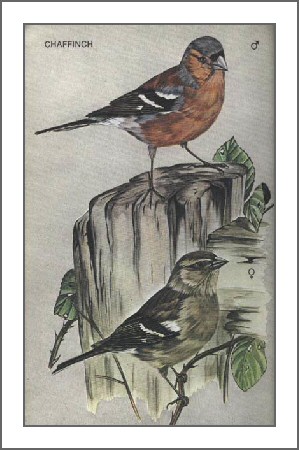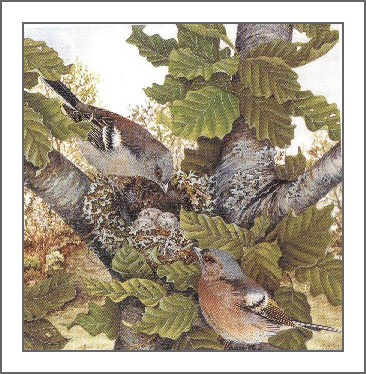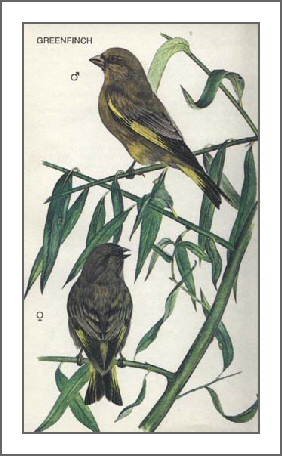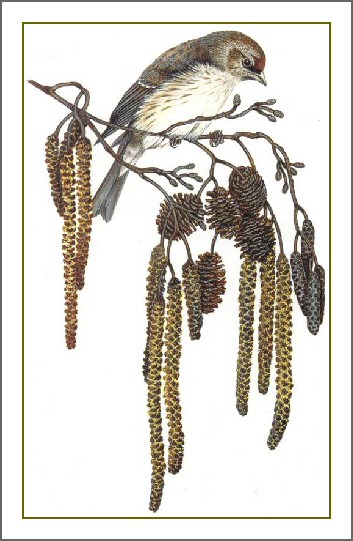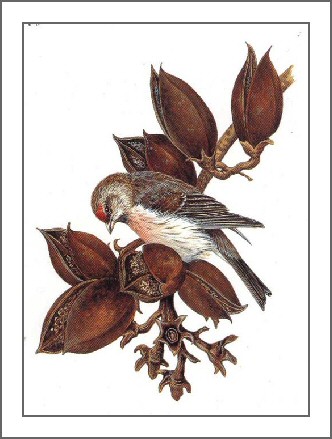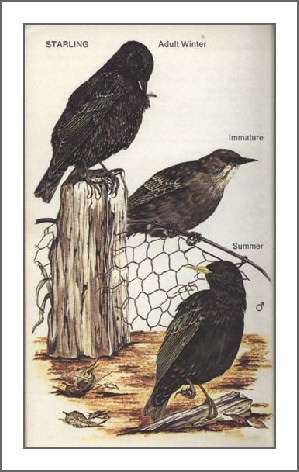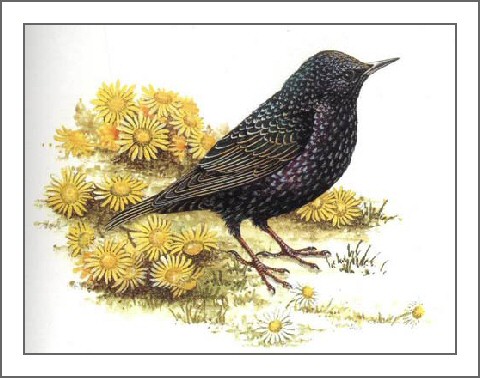

On this page you will find links on the left to pages containing garden birds, bush birds and freshwater birds.
![]()
SCROLL DOWN TO FIND SOME BIRDS YOU MIGHT SEE IN YOUR GARDEN OR LOCAL PARK.
![]()
HOUSE SPARROW - HEDGE SPARROW - SONG THRUSH - CHAFFINCH - GREENFINCH - REDPOLL - STARLING
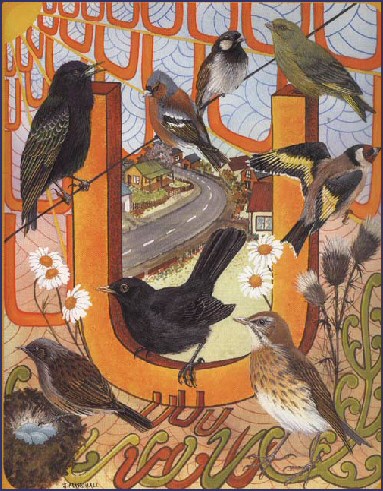
As I stroll along the street, with houses and gardens each side, I see the urban birds at work, as nests they try to hide. There are Starlings in the rooftops, and Sparrows in the eaves, and the Blackbird and Thrush, with their nests in a bush, while the Goldfinch and Chaffinch use trees. The Greenfinch will join them, but there's one bird I know; it's a sweet little Dunnock, whose nest is so low, I can peek inside at blue eggs, all aglow. These are the birds of my urban scene, and some of the prettiest there ever have been. (from K is for KIWI).
![]()
HOUSE SPARROW
House Sparrow Passer domesticus FAMILY: Ploceidae Introduced from Europe 1860s. Not protected. Most commonly seen bird in built up areas. 14.5cms Found throughout NZ in abundance, prefering areas near habitation. Often roosting in large flocks. Feeds on insects, seeds, grain, fruits, scraps, and flax nectar, depending on locality and season. Breeding is from July to April and there are several broods produced each season. The nest is a large, untidy structure of grass lined with feathers, usually in holes in buildings, trees and cliffs and colonies in high trees. The eggs, 5-7, are white, heavily spotted and streaked with greyish-brown. Incubation 13 days, fledging 15 days. 5 or more broods may be produced. Female and juvenile plumage is dull brown above, pale below. HEDGE SPARROW
Hedge Sparrow Prunella modularis FAMILY: Prunellidae Introduced 1868 from Europe. Not protected. 14.5cms. Inconspicuous and solitary bird, moving in short hops with flicking movements of wings and tail. Hence the old name of 'Shufflewing'. Another common name is Dunnock. Common throughout NZ, mainly in gardens, hedges, scrubland, forest edges and clearings. Feeds on insects and small seeds. Breeding is from August to January. The nest is usually close to the ground in thick cover, neatly lined with mosses, hair, fine grasses and sometimes wool. The eggs, 3-5, are pure intense turquoise-blue and incubation takes 12 days, fledging 11-15 days.
SONG THRUSH
SONG THRUSH Turdus philmelos FAMILY: Muscicapidae Introduced from Europe in the 1860s. Not protected. 23cms. Found throughout NZ in gardens, parks and open farmland. Feeds mainly on the ground on worms, slugs, snails, insects, berries and small fruit. Has a loud and rapid alarm call of 'tchik-tchik'. Sexes alike. Breeding is from June to January and more than one clutch is produced. The nest is usually low down, in shrubs and small trees. It is large and made of twigs, roots, grasses and mud, with the deep cup lined with a mixture of rotten wood and saliva. The eggs, 3-6, are clear-blue with black spots scattered mainly at the large end. Incubation 13-14 days, fledging 13-14 days.
CHAFFINCH
CHAFFINCH Fringilla coelebs FAMILY: Fringillidae Introduced from Europe in the 1860s. Not protected. 15cms. Male and female different, the female being mainly brown with the white wing patches. Both sexes have distinctive white outer tail feathers and white wing patch. Flight is undulating. Found throughout NZ, but nowhere in large numbers. Mainly in gardens, orchards and scrubland, but also found in exotic forest and native bush up to the scrubline. Outside the breeding season they often get in loose flocks and during Winter single birds can often be seen in flocks with other finches. Feeds on insects and seeds. Breeds from October to February. The nest is tight, neatly woven, and made of moss, grass and fine roots, plastered on the outside with moss and lichen and lined with fine grass, feathers and thistledown. Often they are built close to a tree trunk, at the fork of a branch. The eggs, 4-6, grey to green-blue with purplish to reddish-brown splotches OR pure blue with slight blackish-purple spots. Incubation 11-13 days, fledging 13-14 days. GREENFINCH
GREENFINCH Carduelis chloris FAMILY: Fringillidae Introduced from Europe during the 1860s. Not protected. 15cms. Forked tail and heavy brown bill, the male is olive green while the female and young are duller and browner. All have distinctive yellow markings on the wings and tail. Plentiful throughout NZ up to 600mt. in open country, gardens, parks, hedges and pine-plantations. Usually in pairs but flocking in Autumn. Feeds on seeds, insect larvae, fleshy fruits, and sometimes leaves and fruit flowers. Breeding is from September to January, with usually two broods. The nest is made of fine sticks, moss and roots, and lined with wool, hair and feathers. Often in a fork in a tree up to 20ft. The eggs, 4-6, are off-white with red-brown spots or streaks. Incubation 13-14 days, fledging 13-16 days. Usually 2 broods. REDPOLL
REDPOLL Acanthis flammea FAMILY: Fringillidae Introduced from Europe 1860s. Not protected. 12cms. Common throughout NZ in scrubland up to sub-alpine, generally away from towns. Feeds mainly on insects, seeds and the soft parts of plants. Breeding is from September to January with often two broods. The nest is small and compact and made from grass, wool and twigs and lined with hair, wool or feathers. The eggs, 4-5, are bluish-white with dark and light brown spots and streaks. Incubation 10-12 days, fledging 11-14 days.
STARLING
STARLING Sturnus vulgaris FAMILY: Sturnidae Introduced from Europe 1862. Not protected. 21cms. Very common throughout NZ, up to sub-alpine except in dense bush. Winter plumage is black speckled with buff-white, bill black, sexes alike. Breeding plumage: Bill yellow. Male mainly black with purple-green gloss, while the female retains the speckling. Immature are dull brown with dark bill. Feeds on worms, grubs, fruit and insects, and often form large flocks in open paddocks and beaches. Breeding is from September to January, with often two broods. They nest in holes in buildings, trees, cliffs and banks and the nest is an untidy mix of grasses and straw,. The eggs, 4-7, are pale blue with a slight gloss. Incubation 13 days, fledging 21 days. Placing wooden nest boxes on poles or trees will attract Starlings to nest in them. |

Copyright(c) 2006 Janet Marshall. All rights reserved.
myid@myhost.com
nbsp;
nbsp;



















